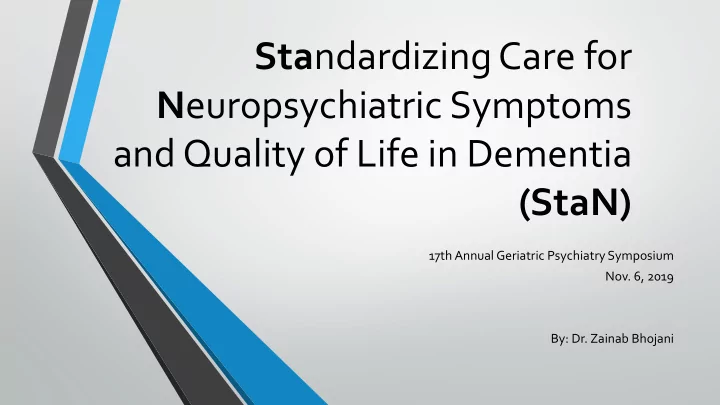

Sta ndardizing Care for N europsychiatric Symptoms and Quality of Life in Dementia (StaN) 17th Annual Geriatric Psychiatry Symposium Nov. 6, 2019 By: Dr. Zainab Bhojani
OBJECTIVES: • propose adopting an algorithmic approach to non-pharmacological interventions, psychotropics use, combined with standardized assessments , non-pharmacological interventions, and measurement-based decision making referred to as the Integrated Care Pathway (ICP).
REASONS FOR I ntegrated C are P athway: • Problem of polypharmacy • Problem of suboptimal dosing • Problem of variation • Problem of absent non-pharmacological interventions • Algorithmic treatment for mental disorders is known to result in better outcomes. • key component is sequential approach to prescribing medications, thereby allowing for the target dose, and an appropriate duration of treatment at the target dose.
Groundwork for INTEGRATED CARE PATHWAY • ICP is based on previous work done at CAMH (CENTRE FOR ADDICTIONS AND MENTAL HEALTH) to evaluate the feasibility and generate pilot data for an ICP approach to treat AD-AA. • Preliminary data (CAMH): 45 patients with AD-AA. • 3 patients (6%) exited the ICP before completion • 42 patients completed the ICP successfully • 25 patients completed the CMAI-frequency scale • PRIMARY OUTCOME MEASURE: total score decreased from 57.5 (SD = 24.5) at baseline to 42.2 (SD = 18.4) at exit from the ICP ( t (24) = 3.59, p = 0.001, Cohen’s d = 0.74). • SECONDARY OUTCOME MEASURE: proportion of participants on polypharmacy. Only 1/42 patients exited the ICP on polypharmacy (2.4%) as compared to rates of up to 50% in the literature
DESIGN • Design features • PARTICIPANTS- SITES, SAMPLE SIZE • Organization • Visit schedule
STUDY DESIGN • 1)Project initiation phase of 6 months (project months: 1-6) • 2) Enroll and randomize 220 participants with AD-AA (110 inpatient and 110 in LTCFs) to ICP vs.TAU. • In this RCT phase of the project, participants will be treated for 12 weeks. (project months: 7-24). RCT WILL be completed by 18 months • 3) During the last part of this project (project months: 25-36), we will analyze the data from the RCT and complete all naturalistic follow-ups. .
Sites: • 7 sites across two settings: • Inpatient (CAMH in Toronto, Douglas Hospital Research Centre in Montreal, Parkwood Institute in London and victoria hospital and the University of Calgary in Calgary) • loNG TERM CARE fACILITIES (ltcf) affiliated with CAMH in Toronto and Parkwood Institute in London ( Dearness Home and McCormick Home). • 220 participants with AD-AA (110 inpatient and 110 in LTCHs) to ICP vs. TAU.
SAMPLE SIZE AND POWER: • During the 18-month RCT phase of the study, plan to recruit and enroll 2-3 participants/month with AD-AA at each of the 7 sites (4 inpatient units and 3 LTCFs) over 15 months for a total of 110 randomized participants per setting (Inpatient and LTCFs)
ELIGIBILITY CRITERIA: • INCLUSION CRITERIA • A clinical diagnosis of Dementia of Alzheimer’s or Mixed type • AD-AA as defined by Agitation in cognitive disorders • Participant or SDM able and willing to provide consent for enrollment in the study • 50 years or older • Medical stability to participate in the trial.
ELIGIBILITY CRITERIA: • EXCLUSION CRITERIA • Having dementia other than Alzheimer’s or Vascular or Mixed type. • DSM-5 diagnoses other than dementia that is thought to be significantly impacting the presentation of AD-AA such as delirium, bipolar disorder, or major depressive disorder. • Any other reason which in the opinion of study investigator will make the study participation intolerable for the participant.
Outcome Measures: • Primary: • Change in Cohen-Mansfield Agitation Inventory - Total Frequency Score (CMAI - Frequency) • baseline, 3 weeks, 8 weeks, and 12 weeks measures burden of agitation in patients with dementia. CMAI-frequency score ranges between 29 to 203, higher scores indicate worsening of symptom • Participants on Polypharmacy • baseline, 3 weeks, 8 weeks, and 12 weeks - percentage and total number of participants on 2 or more psychotropics • Secondary: • The impact of the ICP on falls • Every 2 weeks- Recording the number of fall
Clinical Global Impression of Change
BASELINE AND WEEK 1:
Figure 2: Medications Algorithm: Step-wise Progression.
LEVEL DRUG EVIDENCE 1 Risperidone STRONGEST- Approved in Canada for symptomatic management 2A Aripiprazole WEAKER RCT evidence suggesting efficacy in psychosis associated with AD 2B Quetiapine WEAKER 6 RCTs reported a significant effect in reducing neuropsychiatric symptoms relative to placebo 3 Carbamazepine 1 successful RCT, CYP 3A4 inducer Resistant or Unable to tolerate antipsychotics 4 Citalopram successful large RCT Max dose: 20 mg/day 5 Gabapentin Case series & reports – mainly for sexual disinhibition 6 Prazosin one small RCT- significant evidence ( at 6mg /day) 7 Combination of ANY 2 (Partial Response)
ASSESSMENT TOOLS:
Adverse reactions of ANTIPSYCHOTICS: • movement DISORDERS • PARKINSONISM • AKATHISIA • Tardive dyskinesia
SIMPSON ANGUS SCALE- parkinsonism
SIMPSON ANGUS SCALE- parkinsonism
THANK YOU
Recommend
More recommend